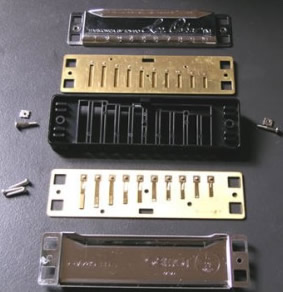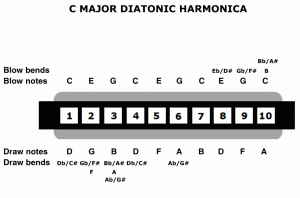Why Are My Harp Notes Set Out This Way?
‘I do desire we may be better strangers.’ As You Like It (William Shakespeare).
Background
 One of the first exercises we learn at the Harp Surgery is playing the major scale from blow 4 up to blow 7 (the mid octave). We use this to develop single note playing and movement around the harp. Simple as it may seem, it’s a great way of learning to navigate the new instrument and to develop an aural awareness of the changes that take place (as we cannot actually see them under our nose). We also use it to warm up at the start of subsequent sessions.
One of the first exercises we learn at the Harp Surgery is playing the major scale from blow 4 up to blow 7 (the mid octave). We use this to develop single note playing and movement around the harp. Simple as it may seem, it’s a great way of learning to navigate the new instrument and to develop an aural awareness of the changes that take place (as we cannot actually see them under our nose). We also use it to warm up at the start of subsequent sessions.
Once the central doh-ray-me is mastered, we then learn to extend upwards from hole 7 to hole 10 (the upper octave) and consider the 10 hole blow bends necessary to complete the sequence. Lastly we apply the process to holes 1 to 4 (the lower octave) and consider the draw bends necessary to complete the pattern. Once we can play the major scale in each octave fluently, including bends, we have the ability to range the length of the harp in 1st position, using it as one homogeneous instrument.
So why is hole 7 back to front?
Coming back to the central scale in holes 4 to 7, there is one thing that sticks out like a sore thumb. Hole 7 is backwards and trips us up every time. For those who are totally new, the mid scale on any 10 hole diatonic runs blow-draw hole 4, blow-draw hole 5, blow-draw hole 6, but then draw-blow in hole 7. Try it. Remember when moving from hole 6 to 7 that there’s no need to stop drawing. Just slide across the harp from 6 and let your breath drop into hole 7, before ending the scale with a blow. The bridge between the two adjacent holes will interupt the airflow and make it sound like two separate notes.
 So why is the pattern reversed in hole 7? To answer the question, let’s pick a standard C major 10 hole diatonic harp (click on the diagram to expand). Let’s focus on the blow notes along the top first. They are arranged in a repeated sequence C-E-G plus a C to complete the ‘club sandwich’. Blow the three (or all four) notes together and you have the C major chord. It’s a full and satisfying combination of notes. Play the same notes individually left to right and right to left. This is ‘arpeggio’. Singers and actors use it to warm their voices before a performance. In first position, or straight harp, this is the chord we start with. We call it the ‘tonic’ or I chord.
So why is the pattern reversed in hole 7? To answer the question, let’s pick a standard C major 10 hole diatonic harp (click on the diagram to expand). Let’s focus on the blow notes along the top first. They are arranged in a repeated sequence C-E-G plus a C to complete the ‘club sandwich’. Blow the three (or all four) notes together and you have the C major chord. It’s a full and satisfying combination of notes. Play the same notes individually left to right and right to left. This is ‘arpeggio’. Singers and actors use it to warm their voices before a performance. In first position, or straight harp, this is the chord we start with. We call it the ‘tonic’ or I chord.
To create interesting tunes, we need somewhere else to move the song on to. This is where the draw holes come in. Draw holes 2 to 4 and you have the G major chord G-B-D. (We also have a D in draw 1 we can add comfortably for a four hole club sandwich chord). This is the ‘dominant’ or V chord. Try it.
Now let’s do a quick experiment. Blow holes 1 to 4. Now draw holes 1-4, stop and wait. You’ve moved from the tonic to the dominant and left the whole thing hanging. You’ve created musical tension. Unless you’re playing the end of a Cajun tune, you should feel the need to resolve the tension by blowing holes 1 to 4 again. Do it! Do it again. Simple stuff, but important.
Now to the point. The arrangement of the blow and draw chords allows us to plot the major scale C-D-E-F-G-A-B-C mid harp, starting from blow 4. So we find C-D in hole 4, E-F in hole 5 and G-A in hole 6. The final C is already in blow 7 as part of that C tonic chord or arpeggio, it’s prescribed and we cannot shift it, which leaves just one option for the missing B. Draw 7. Eureka!
Caution
When we progress to 2nd position (cross harp) blues playing, the ‘reversed’ layout in hole 7 and upwards prevents us from repeating the blues scale pattern we learn in holes 2 to 6 right up to hole 10. So we create a comfort zone on the lower end of the harp and leave the ‘top end’ for others to choke on. We actually start to develop a fear of using the top end and marvel at those daring enough to break into ‘banjo territory’.. NOT GOOD!
At the harp surgery we encourage players to embrace this obstacle and start to bridge it. The more you work at it, the easier it becomes and the better player you become. Look at it another way. You just bought 10 holes. Why be satisfied with only using 60% of your purchase? Would you chuck away 40% of a good pint? I don’t think so. That’s bad budgeting to put it mildly. Well you can’t get a refund on the other 4 holes so start getting value for money. Check out Crossing The Bridge, Top End Harp Playing and Blow Bends.
